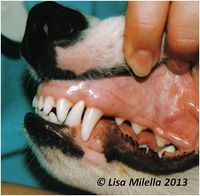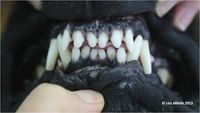Difference between revisions of "Dental Malocclusion"
Michuang0720 (talk | contribs) |
|||
| (28 intermediate revisions by 4 users not shown) | |||
| Line 1: | Line 1: | ||
{{OpenPagesTop}} | {{OpenPagesTop}} | ||
==Introduction== | ==Introduction== | ||
| − | + | [[File:Dog teeth occlusion 2.jpg|right|200px|thumb|Occlusal assessment – mandibular incisors occlude on the palatal aspect of the maxillary incisors (known as a scissor bite), the mandibular canine interdigitates half way between the maxillary canine and third incisor, and the premolars interdigitate in a “picking shear” effect.<small>''© Lisa Milella 2013''</small>]] | |
| + | [[File:Dog incisor occlusion.jpg|right|200px|thumb|Occlusal assessment of the incisors of a dog.<small>''© Lisa Milella 2013''</small>]] | ||
| + | By definition, malocclusion is an abnormality in the position of the teeth. | ||
| − | + | The ideal occlusion can be described as the perfect interdigitation of the upper and lower teeth. In the normal dog, the ideal tooth positions in the arches are defined by the '''occlusal, inter-arch and interdental relationships''' of the teeth. | |
| − | |||
| − | + | The '''ideal relationship''' with the mouth closed can be defined by the following: | |
| + | :Maxillary incisor teeth all positioned rostral to the corresponding mandibular incisor teeth. | ||
| + | :Mandibular canine tooth is inclined labially and bisects the interproximal space between the opposing maxillary third incisor tooth and canine tooth. | ||
| + | :Maxillary premolar teeth do not contact the mandibular premolar teeth. | ||
| + | :The mesial crown cusp of the maxillary fourth premolar tooth is positioned lateral to the space between the mandibular fourth premolar tooth and the mandibular first molar tooth. | ||
| − | + | This is described as '''orthoclusion'''. | |
| − | |||
| − | |||
| − | |||
| − | + | The length of a dog's jaw is most importantly determined by its '''genetic background'''. Problems exist commonly in dogs mainly due to the great variation in skull types within the species. Other factors can influence jaw length during growth, such as diet, metabolism, trauma, infection and forces within the mouth. | |
| − | + | The clinical significance of malocclusion is that it may cause discomfort and sometimes pain to the affected animal. In some cases, it may be the direct cause of severe oral pathology. | |
| − | + | ==Signalment== | |
| − | + | With the mesocephalic skull shape, the mandible is shorter and less wide than the upper jaw. Dolicocephalic breeds have a longer than normal upper jaw. The increased jaw length results in interdental spaces that are wider than normal. Brachycephalic animals have a shorter than normal upper jaw. A short jaw results in reduced interdental spaces with rotation and/or overlap of teeth. | |
| − | |||
| − | |||
| − | |||
| − | |||
| − | |||
| − | |||
| − | |||
| − | |||
| − | |||
| − | |||
| − | |||
| − | |||
| − | + | Malocclusion is common in the dog, but also occurs in cats. | |
| − | |||
| − | |||
| − | |||
| − | |||
| − | |||
| − | |||
| − | |||
| − | |||
| − | |||
| − | |||
| − | |||
| − | |||
| − | + | ==Class 1 malocclusion== | |
| − | + | Also called neutroclusion, this describes a normal rostral-caudal relationship of the maxillary and mandibular dental arches but there is '''malposition of one or more individual teeth'''. | |
| − | Also called | ||
| − | + | ==Class 2 malocclusion== | |
| − | + | This is also called '''mandibular distoclusion, mandibular brachygnathism''' or mandibular retrognathism. | |
In layman's terms this is referred to as an overshot jaw or a parrot mouth. | In layman's terms this is referred to as an overshot jaw or a parrot mouth. | ||
| Line 60: | Line 37: | ||
Breeds commonly affected include the Rough Collie and the Borzoi. | Breeds commonly affected include the Rough Collie and the Borzoi. | ||
| − | + | ==Class 3 malocclusion== | |
| − | + | This is also called '''mandibular mesioclusion, mandibular prognathism'''. | |
In layman's terms this is referred to as an undershot jaw. | In layman's terms this is referred to as an undershot jaw. | ||
| Line 78: | Line 55: | ||
'''Premature loss''' of teeth may be caused by an increased liability to [[periodontitis]]. | '''Premature loss''' of teeth may be caused by an increased liability to [[periodontitis]]. | ||
| − | Owners should also be counselled with | + | Owners should also be counselled with regards the possible '''inheritance''' of the condition. Dogs with severe dental malocclusion should not be bred from. |
| − | == | + | ==Treatment== |
| − | + | The primary aim is to relieve '''pain and discomfort'''. | |
| − | + | '''Dental extraction''' is usually the most rapid method of relieving pain and treating any soft tissue injuries such as palatal trauma from canines. In growing animals, teeth should be exctracted preferably before 12 weeks of age, with great care taken not to damage the developing permanent teeth. Extraction should be performed bilaterally symmetrically to prevent any influence of growth of the jaws. | |
| − | + | If dental malocclusions are relieved early, this will provide the jaws with the maximum time to achieve full growth. | |
| + | Antibiotics may be required if secondary infection is present. | ||
{{Learning | {{Learning | ||
| − | |||
|flashcards = [[Veterinary Dentistry Q&A 09]] | |flashcards = [[Veterinary Dentistry Q&A 09]] | ||
}} | }} | ||
==References== | ==References== | ||
| − | + | Johnson, N. (2009) '''Dentistry 1''' ''RVC student notes'' | |
Verstraete, F. (1999) '''Self-assessment colour review of veterinary dentistry''' ''Manson Publishing'' | Verstraete, F. (1999) '''Self-assessment colour review of veterinary dentistry''' ''Manson Publishing'' | ||
| − | {{ | + | {{review}} |
| − | |||
| − | {{ | + | {{OpenPages}} |
| − | |||
[[Category:Teeth - Pathology]] | [[Category:Teeth - Pathology]] | ||
[[Category:Dental Diseases - Cat]] | [[Category:Dental Diseases - Cat]] | ||
[[Category:Dental Diseases - Dog]] | [[Category:Dental Diseases - Dog]] | ||
| + | [[Category:Expert Review]] | ||
[[Category:Developmental Dental Conditions]] | [[Category:Developmental Dental Conditions]] | ||
| − | |||
| − | |||
Revision as of 16:44, 5 September 2013
Introduction
By definition, malocclusion is an abnormality in the position of the teeth.
The ideal occlusion can be described as the perfect interdigitation of the upper and lower teeth. In the normal dog, the ideal tooth positions in the arches are defined by the occlusal, inter-arch and interdental relationships of the teeth.
The ideal relationship with the mouth closed can be defined by the following:
- Maxillary incisor teeth all positioned rostral to the corresponding mandibular incisor teeth.
- Mandibular canine tooth is inclined labially and bisects the interproximal space between the opposing maxillary third incisor tooth and canine tooth.
- Maxillary premolar teeth do not contact the mandibular premolar teeth.
- The mesial crown cusp of the maxillary fourth premolar tooth is positioned lateral to the space between the mandibular fourth premolar tooth and the mandibular first molar tooth.
This is described as orthoclusion.
The length of a dog's jaw is most importantly determined by its genetic background. Problems exist commonly in dogs mainly due to the great variation in skull types within the species. Other factors can influence jaw length during growth, such as diet, metabolism, trauma, infection and forces within the mouth.
The clinical significance of malocclusion is that it may cause discomfort and sometimes pain to the affected animal. In some cases, it may be the direct cause of severe oral pathology.
Signalment
With the mesocephalic skull shape, the mandible is shorter and less wide than the upper jaw. Dolicocephalic breeds have a longer than normal upper jaw. The increased jaw length results in interdental spaces that are wider than normal. Brachycephalic animals have a shorter than normal upper jaw. A short jaw results in reduced interdental spaces with rotation and/or overlap of teeth.
Malocclusion is common in the dog, but also occurs in cats.
Class 1 malocclusion
Also called neutroclusion, this describes a normal rostral-caudal relationship of the maxillary and mandibular dental arches but there is malposition of one or more individual teeth.
Class 2 malocclusion
This is also called mandibular distoclusion, mandibular brachygnathism or mandibular retrognathism.
In layman's terms this is referred to as an overshot jaw or a parrot mouth.
This describes an abnormal rostral-caudal relationship between the dental arches in which the mandibular arch occludes caudal to its normal position relative to the maxillary arch.
Breeds commonly affected include the Rough Collie and the Borzoi.
Class 3 malocclusion
This is also called mandibular mesioclusion, mandibular prognathism.
In layman's terms this is referred to as an undershot jaw.
This describes an abnormal rostral-caudal relationship between the dental arches in which the mandibular arch occludes rostral to its position relative to the maxillary arch.
One of the breeds most commonly affected is the Boxer.
Clinical Importance of Malocclusion
Even an otherwise sound, well cared-for dentition may show asymmetric abrasion or attrition.
Problems may occur with mastication and temporomandibular joint function.
Soft tissue trauma is a common sequel of malpositioned teeth.
Premature loss of teeth may be caused by an increased liability to periodontitis.
Owners should also be counselled with regards the possible inheritance of the condition. Dogs with severe dental malocclusion should not be bred from.
Treatment
The primary aim is to relieve pain and discomfort.
Dental extraction is usually the most rapid method of relieving pain and treating any soft tissue injuries such as palatal trauma from canines. In growing animals, teeth should be exctracted preferably before 12 weeks of age, with great care taken not to damage the developing permanent teeth. Extraction should be performed bilaterally symmetrically to prevent any influence of growth of the jaws.
If dental malocclusions are relieved early, this will provide the jaws with the maximum time to achieve full growth.
Antibiotics may be required if secondary infection is present.
| Dental Malocclusion Learning Resources | |
|---|---|
 Test your knowledge using flashcard type questions |
Veterinary Dentistry Q&A 09 |
References
Johnson, N. (2009) Dentistry 1 RVC student notes
Verstraete, F. (1999) Self-assessment colour review of veterinary dentistry Manson Publishing
| This article has been peer reviewed but is awaiting expert review. If you would like to help with this, please see more information about expert reviewing. |
Error in widget FBRecommend: unable to write file /var/www/wikivet.net/extensions/Widgets/compiled_templates/wrt693c2e170d2d25_08047004 Error in widget google+: unable to write file /var/www/wikivet.net/extensions/Widgets/compiled_templates/wrt693c2e17148ce8_86802425 Error in widget TwitterTweet: unable to write file /var/www/wikivet.net/extensions/Widgets/compiled_templates/wrt693c2e171fccf0_40227813
|
| WikiVet® Introduction - Help WikiVet - Report a Problem |

